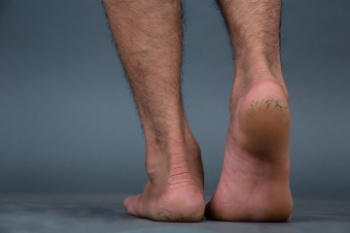Items filtered by date: February 2025
Cracked Heels and Their Causes

Cracked heels occur when the skin on the heels becomes dry, thickened, and splits. These cracks can cause discomfort and lead to infections if left untreated. The primary causes of cracked heels include dry skin, which reduces skin elasticity, and excessive pressure from standing or walking for long periods. Poor footwear choices, such as shoes that do not provide adequate support, can worsen the condition. Certain medical conditions like diabetes and eczema can also contribute to cracked heels, as they affect the skin’s ability to retain moisture. Obesity adds extra pressure on the feet, increasing the risk of cracks or fissures. Additionally, hydration is essential for maintaining skin health, and drinking sufficient water helps prevent the skin from drying out and cracking. Cracked heels can be painful and make it difficult to complete daily activities. If you have developed this condition, it is suggested that you consult a podiatrist who can successfully treat this ailment, which may include prescribed medication.
If the skin on your feet starts to crack, you may want to see a podiatrist to find treatment. If you have any concerns, contact one of our doctors from Andrea Hyperbaric Wound Care & Health Center. Our doctors can provide the care you need to keep you pain-free and on your feet.
Cracked Heels
It is important to moisturize your cracked heels in order to prevent pain, bleeding, and infection. The reason cracked heels form is because the skin on the foot is too dry to support the immense pressure placed on them. When the foot expands, the dry skin on the foot begins to split.
Ways to Help Heal Them
- Invest in a good foot cream
- Try Using Petroleum Jelly
- Ease up on Soaps
- Drink Plenty of Water
Ways to Prevent Cracked Heels
- Moisturize After Showering
- Skip a Shower
- Keep Shower Water Lukewarm
- Don’t Scrub Your Feet
If you are unsure how to proceed in treating cracked heels, seek guidance from a podiatrist. Your doctor will help you with any questions or information you may need.
If you have any questions, please feel free to contact our office located in Astoria, NY . We offer the newest diagnostic and treatment technologies for all your foot care needs.
Managing Plantar Fasciitis

Plantar fasciitis is a common cause of heel pain, typically felt as a sharp or stabbing sensation, especially with the first steps in the morning or after long periods of sitting. The pain is caused by inflammation of the plantar fascia, a thick band of tissue that connects your heel to your toes. Overuse, flat feet, high arches, or wearing unsupportive footwear can increase your risk of developing this condition. In addition to heel pain, you may also experience tightness or swelling along the bottom of the foot. Treatments often include rest, stretching exercises, and wearing supportive shoes or custom orthotics to relieve pressure. In more severe cases, a podiatrist may recommend corticosteroid injections or even surgery. This type of specializes in diagnosing and treating conditions like plantar fasciitis, and they can tailor a treatment plan to help alleviate pain and prevent future flare-ups. If you are struggling with heel pain, it is suggested that you schedule an appointment with a podiatrist for effective treatment solutions.
Plantar fasciitis can be very painful and inconvenient. If you are experiencing heel pain or symptoms of plantar fasciitis, contact one of our doctors from Andrea Hyperbaric Wound Care & Health Center. Our doctors can provide the care you need to keep you pain-free and on your feet.
What Is Plantar Fasciitis?
Plantar fasciitis is the inflammation of the thick band of tissue that runs along the bottom of your foot, known as the plantar fascia, and causes mild to severe heel pain.
What Causes Plantar Fasciitis?
- Excessive running
- Non-supportive shoes
- Overpronation
- Repeated stretching and tearing of the plantar fascia
How Can It Be Treated?
- Conservative measures – anti-inflammatories, ice packs, stretching exercises, physical therapy, orthotic devices
- Shockwave therapy – sound waves are sent to the affected area to facilitate healing and are usually used for chronic cases of plantar fasciitis
- Surgery – usually only used as a last resort when all else fails. The plantar fascia can be surgically detached from the heel
While very treatable, plantar fasciitis is definitely not something that should be ignored. Especially in severe cases, speaking to your doctor right away is highly recommended to avoid complications and severe heel pain. Your podiatrist can work with you to provide the appropriate treatment options tailored to your condition.
If you have any questions please feel free to contact our office located in Astoria, NY . We offer the newest diagnostic and treatment technologies for all your foot and ankle needs.
Podiatrists and Why You May Need One

Podiatry is the branch of medicine focused on diagnosing, treating, and preventing conditions affecting the feet, ankles, and lower extremities. Podiatrists, or Doctors of Podiatric Medicine, DPMs, are medical professionals trained to address everything from common foot pain and injuries to diabetic foot complications and surgical interventions. Podiatric care is provided in private practices, hospitals, sports medicine clinics, and specialized wound care centers. To become a podiatrist, individuals must complete a Doctor of Podiatric Medicine, or DPM degree, followed by a three-year surgical residency. Podiatry benefits people of all ages, especially athletes, diabetic patients, seniors, and individuals with mobility issues. Proper foot care enhances overall well-being, preventing complications that could lead to pain, infection, or even limb loss. If you have foot or ankle pain or any concerns about your lower extremities, it is suggested that you schedule an appointment with a podiatrist.
If you are dealing with pain in your feet and ankles, you may want to seek help from a podiatrist. Feel free to contact one of our doctors from Andrea Hyperbaric Wound Care & Health Center. Our doctors can provide the care you need to keep you pain-free and on your feet.
What Is a Podiatrist?
A podiatrist is a doctor of podiatric medicine who diagnoses and treats conditions of the foot, ankle, and related structures of the leg. Your podiatrist may specialize in a certain field such as sports medicine, wound care, pediatrics, and diabetic care. Podiatrists have the ability to become board certified through training, clinical experience, and then taking an exam.
What Do Podiatrists Do?
On a daily basis, a podiatrist may perform the following activities:
- Diagnose foot ailments such as ulcers, tumors, fractures, etc.
- Use innovative methods to treat conditions
- Use corrective orthotics, casts, and strappings to correct deformities
- Correct walking patterns and balance
- Provide individual consultations to patients
It is very important that you take care of your feet. It’s easy to take having healthy feet for granted, however foot problems tend to be among the most common health conditions. Podiatrists can help diagnose and treat a variety of feet related conditions, so it is crucial that you visit one if you need assistance.
If you have any questions please feel free to contact our office located in Astoria, NY . We offer the newest diagnostic and treatment technologies for all your foot and ankle needs.
What to Do About a Sprained Ankle

A sprained ankle occurs when the ligaments that connect the bones in the ankle are stretched or torn, typically from twisting, rolling, or landing awkwardly on the foot. It differs from a strain, which involves damage to the muscles or tendons. Symptoms of a sprained ankle include pain, swelling, bruising, and difficulty moving the ankle, especially when walking or standing. The pain often intensifies when weight is placed on the injured foot. Treatment for a sprained ankle usually includes rest and elevation. In severe cases, a brace or crutches may be necessary to keep weight off the foot. Targeted exercises may also be recommended to strengthen the ankle and prevent future injuries. A podiatrist can assess the severity of the sprain, offer pain relief options, and guide you through rehabilitation exercises for proper healing. If you are experiencing ankle pain, it is suggested that you schedule an appointment with a podiatrist.
Ankle sprains are common but need immediate attention. If you need your feet checked, contact one of our doctors from Andrea Hyperbaric Wound Care & Health Center. Our doctors can provide the care you need to keep you pain-free and on your feet.
How Does an Ankle Sprain Occur?
Ankle sprains take place when the ligaments in your ankle are torn or stretched beyond their limits. There are multiple ways that the ankle can become injured, including twisting or rolling over onto your ankle, putting undue stress on it, or causing trauma to the ankle itself.
What Are the Symptoms?
- Mild to moderate bruising
- Limited mobility
- Swelling
- Discoloration of the skin (depending on severity)
Preventing a Sprain
- Wearing appropriate shoes for the occasion
- Stretching before exercises and sports
- Knowing your limits
Treatment of a Sprain
Treatment of a sprain depends on the severity. Many times, people are told to rest and remain off their feet completely, while others are given an air cast. If the sprain is very severe, surgery may be required.
If you have suffered an ankle sprain previously, you may want to consider additional support such as a brace and regular exercises to strengthen the ankle.
If you have any questions please feel free to contact our office located in Astoria, NY . We offer the newest diagnostic and treatment technologies for all your foot and ankle needs.

